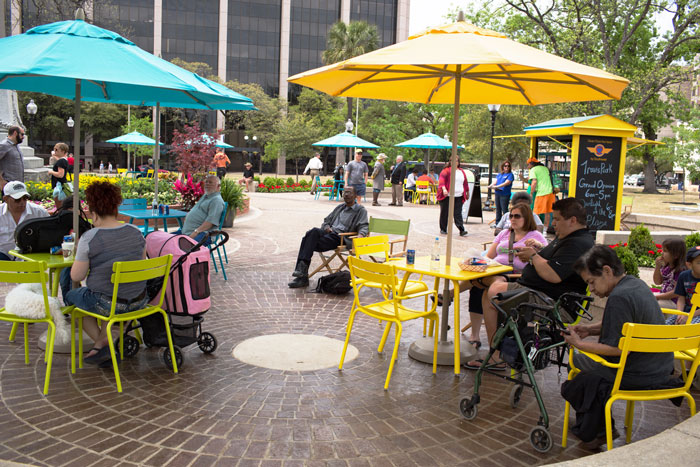Scenery, flora and fauna can draw you to an outdoor space, but it’s what you can do there that turns a pretty view or a public plaza into a place for recreation and community. Site amenities and accessories signal that you are welcome to sit and linger, eat with friends or bring your dog, and let you enjoy these spaces responsibly with refuse and recycling bins. But benches, tables, signs and more can also tell you about the history or significance of the area and can communicate what a community wants to encourage or remember.
And if that seems to turn many outdoor spaces into areas that need to be thoughtfully planned out and cared for constantly, that is exactly what has to happen.
“The ongoing management, programming and care of public spaces is one of the most underestimated factors in the success of well-used and well-loved public space,” said Elena Madison, director of projects for the Project for Public Spaces.
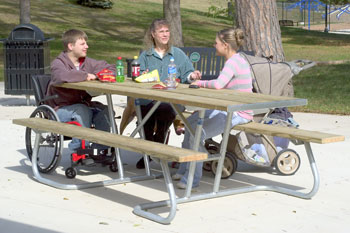
Well-used and well-loved are always goals for those who manage public spaces, but this attention can hurt, both in wear and tear and in acts of vandalism. It’s important for designers and manufacturers of park accessories to learn each facility’s unique needs.
“What are facilities managers telling you about their needs that may be guiding new products and services?” asked Adam Struck, marketing manager with a Cherokee, Iowa-based manufacturer of site furnishings and amenities.
Sometimes the need is for tables, signs and sanitation stations that stand up to snow and rain, heat and cold, and perhaps other conditions that a changing climate will throw at an outdoor space.
The climate for a park can change in other ways. A fitness course that was popular in the 1990s may be better used as a dog park now. Idle tennis courts might be adapted for pickleball. Or maybe a neighborhood now likes to come together for picnics and needs more tables and chairs that can move around.
“There is no one-bench-fits all,” said Madison.
Here Comes the Sun—and the Snow
Although the Project for Public Spaces focuses on bringing public spaces to life, or back to life, by planning and designing them with the people who use them every day, Madison said park managers are a big part of that process, and they have wish lists, too.
“They often ask, ‘Can you recommend a bench that lasts forever and requires no maintenance?’” Madison said.
This is where her team guides park planners through ways to cut down on work and replacement costs, both in time and money.
“Think of (what) makes a bench appealing to sit: Is there shade? Will the bench be too cold in the winter?” she said.
Madison outlined some of the deliberating park managers have to do when it comes to materials and colors. For example, dark colors are often preferred because of design standards or beliefs that they are easier to maintain. But a black bench in the summer might not be very popular if it’s sitting in direct sun.
The good news is, there are plenty of other options. “Thermoplastic coated picnic tables and benches are very popular due to their durability and color choices,” said Struck.
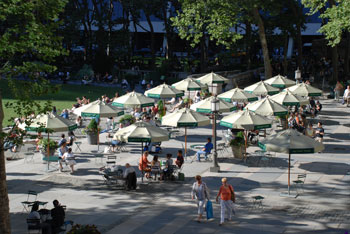
That’s a good starting point. From there, parks managers have to assess their particular location and climate, and how those can affect the materials chosen.
“Stainless-steel and recycled plastic are very popular in coastal regions due to the erosion caused by salt and humidity. In higher elevations where it is common to get snow measured in feet as opposed to inches, thermoplastic coated expanded steel and perforated steel are very popular, especially tables and fire rings that have been snow-load-tested and rated,” Struck said.
And now the dependability of traditional materials such as metal and wood comes in recycled products as well.
“One of the great features of our recycled products is their exceptional durability, backed by a solid 10-year warranty,” said Mimi Marler, director of marketing for a Red Bud, Ill.-based manufacturer of site furnishings and other parks and recreation amenities. “When communities invest in our recycled amenities, they are not only making an environmentally responsible choice by using recycled materials, but also ensuring a long-lasting solution for their outdoor spaces.”
Enduring various weather conditions and heavy usage while maintaining their structural integrity and visual appeal is the goal, she said.
The market has also called for more visually appealing options for park amenities, reflecting traditional or modern design, or natural features of the local area.
“Coatings and finishings are big drivers of change and innovation, especially with higher-end architectural-grade furnishings,” said Marler. “Along with an expanded color pallet, we have also introduced new natural hardwood options as well as textured recycled planks that mimic natural wood grain. We are constantly looking for new and improved finishes to meet our customers’ needs and meet market demands.
“This design diversity ensures that you can select the site furnishings that seamlessly integrate with your community’s unique character and design preferences,” she added.
Disconnection Does a Disservice
Public spaces are available to everyone—and this can be either the best or worst thing about them. Whether vandalism is chronic or due to a burst of warm spring weather just as school lets out, the damage is done either way.
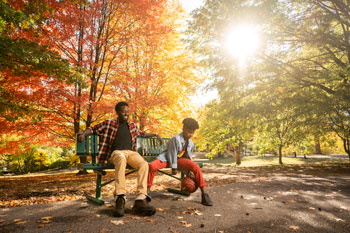
“It’s a challenge,” said Madison.
Marler said that when vandalism is a concern, park planners should look for “site furnishings [that] are designed to be resistant to such damage.” Thermoplastic coating used on her company’s products, for example, can resist “…attempts to cut or carve, meaning no unwanted personalization from the public.
“In addition, we do provide guides on graffiti removal and coating repairs, should vandalism occur. Vendor expertise promotes responsible park use but also ensures that our community spaces remain attractive and well-maintained for years to come,” she said.
Sometimes the conversation about damage to park amenities can include thoughts of how to make spaces even more inviting and inspiring.
“Vandalism occurs because people don’t feel connected to the space—there is nothing compelling for them in the public space,” Madison said.
“Investing in appealing park amenities serves as an investment in the community. A well-designed park area instills a sense of pride among community members, encouraging them to take better care of the park,” said Marler.
Moreover, she added, when people take pride in their community’s parks, they become advocates for their maintenance and upkeep. “They are more inclined to report any issues or concerns to the authorities promptly. They organize community events and cleanup initiatives, fostering a sense of togetherness and civic responsibility.”
Madison agrees. “People generally respect the public good,” she said.
She tells the story of Bryant Park in New York City, a space that was perceived as unsafe in the 1980s but is now one of the best examples of a popular, busy, welcoming city park. One of the strategies used there are movable bistro chairs, which can be used for food-truck dining, people watching and other park programming and events. Every day there are 400 very portable chairs set up in the park, Madison said, but most loss is due to wear and tear, not stealing.
Madison recognizes that often parks managers are wary of furniture and play equipment that can be moved by anyone, but the message it sends is powerful.
These types of amenities “give a lot of personal control to the user over their personal space. It sends a tremendous message (to the public) that they’re in control,” she said.
By the Community, For the Community
The Project for Public Spaces helped Bryant Park along with other park spaces across the country transform into the kinds of gathering places each community wanted. Madison said her team’s job is to listen and interpret.
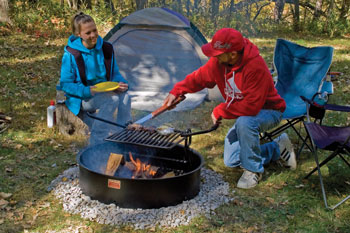
“As we progress through the process of community visioning, design and implementation, we make sure public spaces thrive long after our work is done by developing effective management plans and building the capacity of local partners to carry them out.”
“Our program plans include a menu of activities, amenities and events that can take place in a public space during every time of day, every day of the week and every season. Our management plans include community-driven models of governance and equitable approaches to public safety, procurement and partnerships with social service organizations.”
Madison described her group’s game plan as “lighter, quicker, cheaper,” or implementing strategic changes that promote a longer-term plan. “Some solutions are not intentional design solutions, but organic. Sometimes the solution is not a piece of furniture. The solution is programmatic,” she said.
Working with partners in the community helps fill out a programming schedule, can lead to savings on furnishings and supplies, and can help out with any staffing needs. Bring out the robotics club, a library program or a senior exercise class, Madison suggested.
“The resources are already there,” she said. “We just have to be creative.”
This means getting out of traditional silos that often keep the Recreation, Transportation, Public Works and other departments from collaborating.
Bryant Park in New York City is now managed by a separate corporation that works with the city, the library that shares the space and other local groups to offer ping-pong, a giant chess set, a Winter Village, movies and more.
Before any permanent changes take place, Madison recommends temporary fixes, such as placing tables and chairs in an area to see how people want to use the space. This also allows parks managers to observe how the accessories work in the area throughout the day and the seasons.
Madison said that for public space designers, meeting community needs can be taken as a creative challenge. Companies that make park amenities can meet almost any need out there.
“We understand that every community has unique needs and preferences when it comes to their park amenities. We offer a diverse selection of materials, allowing you to tailor your choice to meet your community’s specific requirements,” said Marler.
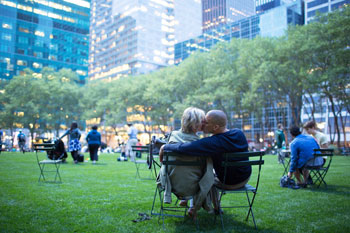
This can include using a space to commemorate a person or event that has significant meaning to a community.
“Another huge trend we are seeing right now is personalization. Communities love that they can add their logo or community names to a lot of our products,” said Marler.
Weather, human behavior, disruptions to the supply chain and other forces well beyond the scope of a neighborhood gathering area mean park planners and managers who recognize the necessity of flexibility will see the most success.
“We really do a good job of forecasting for future needs as far as materials go. The past couple of years it has been challenging getting some materials in, so we really have to keep a finger on the pulse of the supply and demand of materials we use,” said Struck.
“Flexibility empowers communities to create outdoor spaces that are not only enduring but also reflective of their distinct personality and goals,” said Marler. RM



